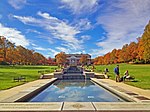Memorial Chapel (University of Maryland)
Churches completed in 1952Military monuments and memorials in the United StatesReligious buildings and structures in Prince George's County, MarylandUniversity and college chapels in the United StatesUniversity of Maryland, College Park ... and 2 more
University of Maryland, College Park facilitiesVietnam War monuments and memorials in the United States

Memorial Chapel is a non-denominational building on the campus of the University of Maryland, College Park, constructed to honor those associated with the university who had lost their lives serving in the United States Armed Forces. The building, designed by Henry Powell Hopkins, actually is made up of three chapels: the Main Chapel, the West Chapel, and the Chapel of the Blessed Sacrament. A Vietnam Veterans Memorial was constructed on the Chapel grounds in 1988. The steeple of the chapel is the highest point on campus.
Excerpt from the Wikipedia article Memorial Chapel (University of Maryland) (License: CC BY-SA 3.0, Authors, Images).Memorial Chapel (University of Maryland)
Regents Drive, College Park Old Town
Geographical coordinates (GPS) Address Website External links Nearby Places Show on map
Geographical coordinates (GPS)
| Latitude | Longitude |
|---|---|
| N 38.983999 ° | E -76.941086 ° |
Address
Memorial Chapel
Regents Drive 7744
20742 College Park, Old Town
Maryland, United States
Open on Google Maps




